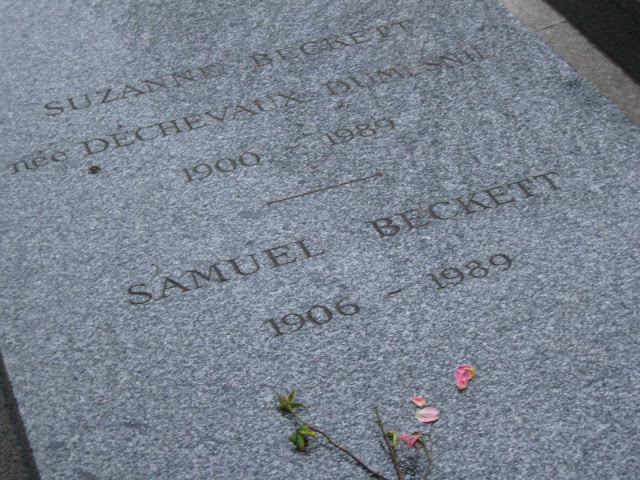A walk through Samuel Beckett's neighbourhood

'Hand in hand from the top of the Eiffel Tower, among the first. We were respectable in those days. Now it's too late. They wouldn't even let us up.'
Samuel Beckett, Waiting for Godot
'Paris: The crucible in which Samuel Beckett's reading turned into writing [...] In 1936 Samuel Beckett moved into the Hotel Libéria. After a stabbing incident, he remet Suzanne Deschevaux-Dumesnil. In 1937 they moved to a seventh-floor studo at 6 Rue des Favorites, in the 15th arrondissement. They lived there until 1961, when SB moved to his final address, a purpose-built flat in the 14th at 38 Boulevard St. Jacques, near the "Falstaff" and "hygienic anonymity" of the Bar Américain in the Hŏtel PLM, where he often met visitors.'
C. J. Ackerley and Stanley Gontarski
On New Year's Day I woke up in a beautiful hotel room in Paris, the city of lights. And as bright morning sunshine streamed through a window overlooking a courtyard, I sat at the edge of the bed collecting my things together. I had an old paperback copy of Samuel Beckett's Endgame, a series of photographs taken by John Minihan, and a list of addresses carefully written onto several slips of paper. Jennifer and I were going in search of Samuel Beckett, a writer who had died in the city almost exactly nineteen years before.
I've been interested in Samuel Beckett's writing for a long time. His poems, plays, novels and short stories hold a strong grip on my imagination, and seem to offer something inescapable that I'm am constantly returning to. I came to Paris to celebrate the coming of the New Year, but the city's strong links with Beckett's writing and his personal life were too powerful to resist.
One of the most memorable moments of the trip was stumbling across the Boulevard St. Jacques, where Beckett lived from the early 1960s until the final year of his life in 1989. The architecture seemed to vary between classic French apartment buildings, with balconies at each of the windows, and modest residential quarters built in the latter-half of the twentieth century. As Jennifer and I passed along the street, I could barely contain my excitement, recalling scenes from James Knowlson's biography of Beckett, and the recollections of personal friends.
We passed where some of Beckett's key social haunts once stood, but found that many of them were as absent as the man himself. I had hoped that we could enter Le Petit Cafe at the PLM Hŏtel - it had been an inconspicuous place for Beckett to meet with friends and acquaintances in relative anonymity. But the writer's social haunt on the Boulevard St. Jacques was nowhere to be found.

We took a left at the end of Beckett's street, and walked along the Avenue Coty. A pathway down the middle of the road had been built to accommodate pedestrians and tourists, and a sign had been erected to mark the Allée Samuel Beckett.

'Paris had finally claimed him as its own. Samuel Beckett's last resting place, beside his wife Suzanne, was in the Cimitière de Montparnasse, in the heart of the city that had shaped his world as Dublin had, and was now his permanent home.'
C. J. Ackerley and Stanley Gontarski
Jennifer and I left the cemetery together, and I was awe-struck. I still am, actually. I thought of all the thousands of words I had read, both by him and about him, and about how strange it feels to have an obsession. I was glad to have paid my respects, and shared an absurd moment with Jennifer. A unique tribute. But we did not stay long. It was dark all around, and the cemetery gates were beginning to close.
In the quiet of the cemetery, the only thing that could be heard was the tolling of the closing bells. Thinking back on it now, I'm reminded of the end of Beckett's novel Murphy, as Celia and Mr. Kelly leave the park at closing time:
'The wail of the rangers came faintly out of the east against the wind. All out. All out. All out. (...) Celia toiled along the narrow path into the teeth of the wind, then faced north up the wide hill. There was no shorter way home. The yellow hair fell across her face. The yachting-cap clung like a clam to the skull. The levers were the tired heart. She closed her eyes.
'All out.'


